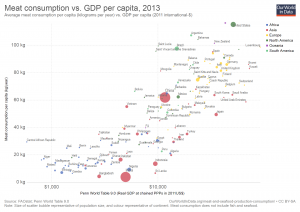 Find out by going to Climate Central’s post, See How Much Winters Have Been Warming in Your City. The winner is Burlington, Vermont, with about 7 degrees F of warming since 1970 (graph here from the post). There is a drop down menu where you can select from most major cities in the U.S. They don’t provide the data, unfortunately, but they do provide a clear methodology so that you can create the data set for your city. You can get weather data from NOAA Climate Data Online. There is great potential here for student projects in statistics courses.
Find out by going to Climate Central’s post, See How Much Winters Have Been Warming in Your City. The winner is Burlington, Vermont, with about 7 degrees F of warming since 1970 (graph here from the post). There is a drop down menu where you can select from most major cities in the U.S. They don’t provide the data, unfortunately, but they do provide a clear methodology so that you can create the data set for your city. You can get weather data from NOAA Climate Data Online. There is great potential here for student projects in statistics courses.
Where do you go to find the major climate events in the last 7 years?
![]() You go to NOAA’s Event Tracker. The initial page is captured in the image here. Each dot represents an event. Scroll over the dot to get a title and summary, which you can then click on to go to the main story. On the bottom right you can select a month since December 2010 to see the events from just that month.
You go to NOAA’s Event Tracker. The initial page is captured in the image here. Each dot represents an event. Scroll over the dot to get a title and summary, which you can then click on to go to the main story. On the bottom right you can select a month since December 2010 to see the events from just that month.
How many people don’t have access to electricity?
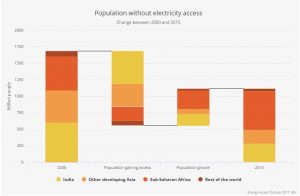 The International Energy Agency’s Energy Access Outlook 2017 has your answer. For example, the chart here answers the question for 2000 and 2015 with an interesting graphic that includes how the change occurred. In 2000, 1684 million people lacked access, 1130 million people gained access, but population grew by 557 million people, leaving 1111 million people without access in 2015. The graph is interactive on the page and breaks these changes down into four regions. There are eight other interesting charts related to electricity as well as access to clean cooking.
The International Energy Agency’s Energy Access Outlook 2017 has your answer. For example, the chart here answers the question for 2000 and 2015 with an interesting graphic that includes how the change occurred. In 2000, 1684 million people lacked access, 1130 million people gained access, but population grew by 557 million people, leaving 1111 million people without access in 2015. The graph is interactive on the page and breaks these changes down into four regions. There are eight other interesting charts related to electricity as well as access to clean cooking.
How do types of electricity production compare?
 The Our World in Data blog post, A sense of units and scale for electrical energy production and consumption has the graph here. It provides a comparison of the scale of different types of electricity production along with comparisons to consumption. For example the Three Gorges Dam is worth 270,000 MWh while the Hoover Dam provides 11,000 MWh. On the other hand the Alta onshore wind form generates 7,342 MWh. The post has a nice discussion of units as well as information about the types of electricity generation they highlight in the graphic.
The Our World in Data blog post, A sense of units and scale for electrical energy production and consumption has the graph here. It provides a comparison of the scale of different types of electricity production along with comparisons to consumption. For example the Three Gorges Dam is worth 270,000 MWh while the Hoover Dam provides 11,000 MWh. On the other hand the Alta onshore wind form generates 7,342 MWh. The post has a nice discussion of units as well as information about the types of electricity generation they highlight in the graphic.
How much do you know about the production and consumption of protein?
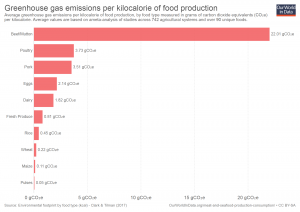 If you read the post by Our World in Data, Meat and Seafood Production & Consumption, you will be able to impress your friends. The post consists of 34 graphs. You can download the images and the data for each. The graph here is Greenhouse gas emissions per gram of protein by food type. Beef is far more CO2 intensive than any other protein source. The second chart here shows Meat consumption vs. GDP per capita (2013) and the U.S. is one of the top two consumers of meat.
If you read the post by Our World in Data, Meat and Seafood Production & Consumption, you will be able to impress your friends. The post consists of 34 graphs. You can download the images and the data for each. The graph here is Greenhouse gas emissions per gram of protein by food type. Beef is far more CO2 intensive than any other protein source. The second chart here shows Meat consumption vs. GDP per capita (2013) and the U.S. is one of the top two consumers of meat.
What is the pay gap between Hispanic women vs white non-Hispanic men?
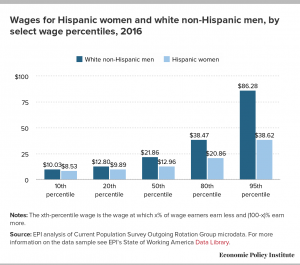 The Economic Policy Institute has the answer with their post Latina workers have to work 10 months into 2017 to be paid the same as white non-Hispanic men in 2016. They compare not only wages by percentile (graph here), but also compare by occupation and education.
The Economic Policy Institute has the answer with their post Latina workers have to work 10 months into 2017 to be paid the same as white non-Hispanic men in 2016. They compare not only wages by percentile (graph here), but also compare by occupation and education.
Much of these differences are grounded in the presence of occupational segregation. Latina workers are far more likely to be found in certain low-wage professions than white men are (and less common in high-wage professions). But, even in professions with more Latina workers, they still are paid less on average than their white male colleagues.
As Hispanic women increase their educational attainment, their pay gap with white men actually increases. The largest dollar gap (more than $17 an hour), occurs for workers with more than a college degree.
The EPI post includes downloadable graphs (such as the one here) as well as the data.
What is the connection between Greenland and the East Coast of the U.S.?
 In NASA’s post, Greenland melt speeds East Coast sea level rise, they explain:
In NASA’s post, Greenland melt speeds East Coast sea level rise, they explain:
The recent work reveals a substantial acceleration in sea level rise, roughly from Philadelphia south, starting in the late 20th century. And it is likely a strong confirmation of sea-level “fingerprints,” one of the most counter-intuitive effects of large-scale melting: As ice vanishes, the loss of its gravitational pull lowers sea level nearby, even as sea level rises farther away.
Their analysis shows that the Greenland and Antarctic influence alone would account for an increase in the rate of sea level rise on the East Coast of 0.0016 to 0.0059 inches (0.04 to 0.15 millimeters) each year, varying by location. That’s equivalent to 7.8 inches (0.2 meters) of sea-level rise on the northern East Coast over the next century, and 2.5 feet (0.75 meters) in the south, though the estimates are quantitative and not an attempt at an actual projection.
Emphasis here in increase as this is in addition to the increases based on the meted water and thermal expansion of the water. Connected to this article, is the graph here, change in Greenland ice in Gt, which is from NASA’s Greenland page where you can also get the data.
How are king tides changing?
 King tides occur when the sun is closest to the earth and aligned with the moon. For the northern hemisphere this happens in the fall. The picture here from the climate.gov post, King tides cause flooding in Florida in fall 2017, is from October,17 2016 at Brickell Bay Drive and 12th Street in downtown Miami.
King tides occur when the sun is closest to the earth and aligned with the moon. For the northern hemisphere this happens in the fall. The picture here from the climate.gov post, King tides cause flooding in Florida in fall 2017, is from October,17 2016 at Brickell Bay Drive and 12th Street in downtown Miami.
While the celestial mechanisms that cause these king tides are not changing anytime soon, the water levels of the oceans are. This means that as the sun and moon tug away at the ocean, they are tugging at an ever-larger amount of water, dragging more of it on-shore than they did during previous decades’ king tides.
The article includes the graph here of maximum daily water levels during king tides near Miami, with a  regression line. The trend shows a water level increase of almost 10 inches since 1994. To get the data go to the Tides and Current page from NOAA, click on the pin by Miami, and then click on the station home page. Under the tides/water level tab go to water level. There is some work involved in the settings to get the data, but there is really interesting data available.
regression line. The trend shows a water level increase of almost 10 inches since 1994. To get the data go to the Tides and Current page from NOAA, click on the pin by Miami, and then click on the station home page. Under the tides/water level tab go to water level. There is some work involved in the settings to get the data, but there is really interesting data available.
Is sexual harassment a serious problem?
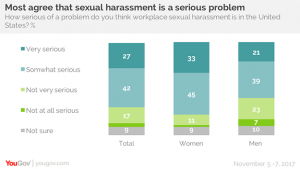 YouGov asked the question, How serious of a problems do you think workplace sexual harassment is in the United States? Very serious or somewhat serious was the response of 70% of the respondents.
YouGov asked the question, How serious of a problems do you think workplace sexual harassment is in the United States? Very serious or somewhat serious was the response of 70% of the respondents.
But for women it is a greater concern: 78% of women say sexual harassment in the workplace is a serious problem today, and 33% of women say it is a very serious problem). 60% of men agree it is a serious issue, with 21% calling it very serious.
The article has more questions and graphs. The most interesting may be the breakdown by gender and political party.
However, Republicans are less likely than Democrats to say sexual harassment in the workplace is a serious problem in the United States – and that’s especially true among Republican men. Democrats – both men and women – are more likely to describe workplace harassment as a very serious problem. But there are big differences between Republican men and women. Seven in ten Republican women say sexual harassment in the workplace is a serious problem; less than half of Republican men agree.
Republican men have a very different view on this issue. At the bottom of the article there is a link to the data, which can easily be incorporated into a stats class followed by an interesting classroom discussion.
What country produces the greatest amount of their electicity with renewable resources?
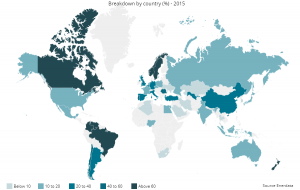 In 2015, the winner is Norway by producing 97.7% of their electricity needs through renewable energy. The top 3 is completed with New Zealand (80.1%) and Columbia (77.7%). The U.S. produces only 13.6% of their electricity with renewable energy. You can learn more from the Global Energy Statistics Yearbook 2017. The data on renewable energy production dates back to 1990. You can download graphs like the one here and the data sets (after registering).
In 2015, the winner is Norway by producing 97.7% of their electricity needs through renewable energy. The top 3 is completed with New Zealand (80.1%) and Columbia (77.7%). The U.S. produces only 13.6% of their electricity with renewable energy. You can learn more from the Global Energy Statistics Yearbook 2017. The data on renewable energy production dates back to 1990. You can download graphs like the one here and the data sets (after registering).
